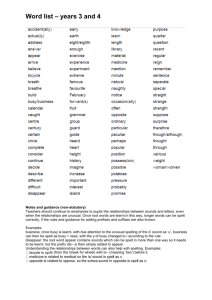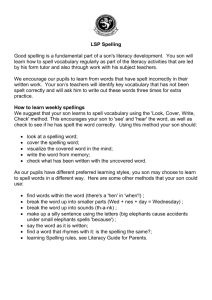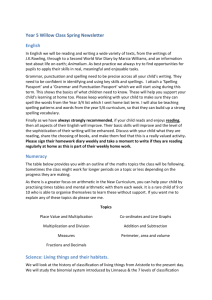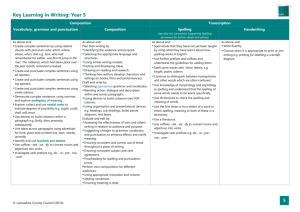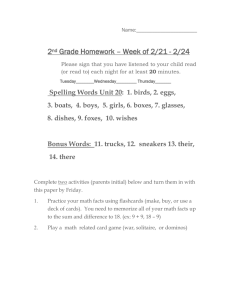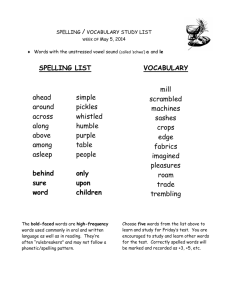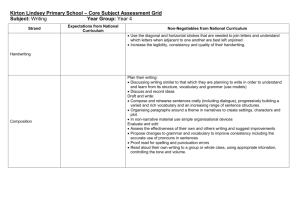Spelling & GPS ARE - Woodcote Primary School
advertisement
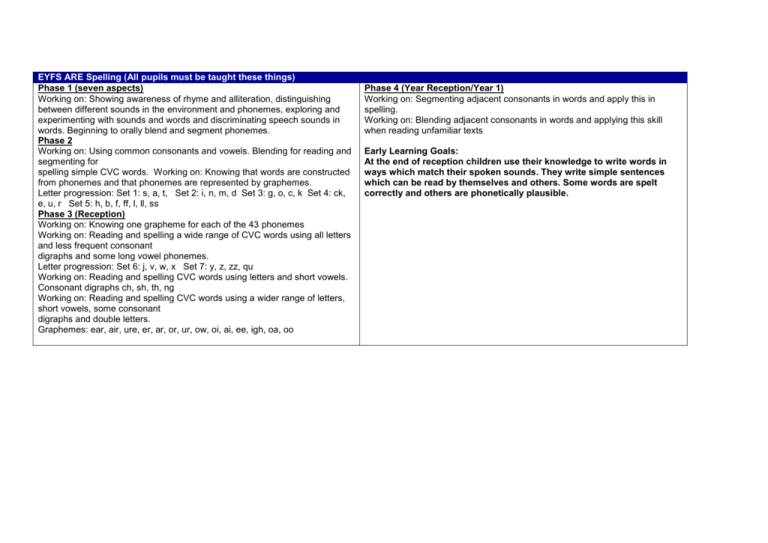
EYFS ARE Spelling (All pupils must be taught these things) Phase 1 (seven aspects) Working on: Showing awareness of rhyme and alliteration, distinguishing between different sounds in the environment and phonemes, exploring and experimenting with sounds and words and discriminating speech sounds in words. Beginning to orally blend and segment phonemes. Phase 2 Working on: Using common consonants and vowels. Blending for reading and segmenting for spelling simple CVC words. Working on: Knowing that words are constructed from phonemes and that phonemes are represented by graphemes. Letter progression: Set 1: s, a, t, Set 2: i, n, m, d Set 3: g, o, c, k Set 4: ck, e, u, r Set 5: h, b, f, ff, l, ll, ss Phase 3 (Reception) Working on: Knowing one grapheme for each of the 43 phonemes Working on: Reading and spelling a wide range of CVC words using all letters and less frequent consonant digraphs and some long vowel phonemes. Letter progression: Set 6: j, v, w, x Set 7: y, z, zz, qu Working on: Reading and spelling CVC words using letters and short vowels. Consonant digraphs ch, sh, th, ng Working on: Reading and spelling CVC words using a wider range of letters, short vowels, some consonant digraphs and double letters. Graphemes: ear, air, ure, er, ar, or, ur, ow, oi, ai, ee, igh, oa, oo Phase 4 (Year Reception/Year 1) Working on: Segmenting adjacent consonants in words and apply this in spelling. Working on: Blending adjacent consonants in words and applying this skill when reading unfamiliar texts Early Learning Goals: At the end of reception children use their knowledge to write words in ways which match their spoken sounds. They write simple sentences which can be read by themselves and others. Some words are spelt correctly and others are phonetically plausible. Year 1 (All pupils must be taught these things) Spelling Revision of Reception work The boundary between revision of work covered in Reception and the introduction of new work may vary according to the programme used, but basic revision should include: all grapheme-phoneme correspondences which have been taught the process of segmenting spoken words into sounds before choosing graphemes to represent the sounds words with adjacent consonants; rules and guidelines which have been taught vowel digraphs which have been taught The sounds /f/, /l/, /s/, /z/ and /k/ spelt ff, ll, ss, zz and ck The /ŋ/ sound spelt n before k Division of words into syllables The /v/ sound at the end of words Adding the endings –ing, –ed and –er to verbs where no change is needed to the root word Vowel digraphs and trigraphs ai, oi, ay, oy, a-e, e-e, i-e, o-e, u-e, ar, ee, ea, er, ir, ur, oo, oa, oe, ou, ow, ue, ie, igh, or, ore, air, ear, are, Words ending –y (/i:/ or /ɪ/ depending on accent) New consonant spellings ph and wh Using k for the /k/ sound Compound words Phase 5 (Year 1) Working on: Reading phonically decodable two syllable and three-syllable words. Working on: Using alternative ways of pronouncing and spelling the graphemes corresponding to the long vowel phonemes. (More able) Working on: Spelling complex words using phonically plausible attempts First 100 high frequency words Pupils should be taught to spell: words containing each of the 40+ phonemes already taught common exception words the days of the week name the letters of the alphabet: naming the letters of the alphabet in order using letter names to distinguish between alternative spellings of the same sound add prefixes and suffixes (most able): using the spelling rule for adding –s or –es as the plural marker for nouns and the third person singular marker for verbs using the prefix un– (most able) using –ing, –ed, –er and –est where no change is needed in the spelling of root words (e.g. helping, helped, helper, eating, quicker, quickest) apply simple spelling rules and guidelines, as listed in Appendix 1 write from memory simple sentences dictated by the teacher that include words taught so far. Vocabulary, Grammar and Punctuation Word Regular plural noun suffixes –s or –es [for example, dog, dogs; wish, wishes], including the effects of these suffixes on the meaning of the noun Suffixes that can be added to verbs where no change is needed in the spelling of root words (e.g. helping, helped, helper) How the prefix un– changes the meaning of verbs and adjectives [negation, for example, unkind, or undoing: untie the boat] Sentence How words can combine to make sentences Joining words and joining clauses using and Text Sequencing sentences to form short narratives Punctuation Separation of words with spaces Introduction to capital letters, full stops, question marks and exclamation marks to demarcate sentences Capital letters for names and for the personal pronoun I Terminology for pupils letter, capital letter word, singular, plural sentence punctuation, full stop, question mark, exclamation mark Year 2 (All pupils must be taught these things) Spelling Phase 6 (Year 2) Working on: Recognising phonic irregularities. and becoming more secure with less common grapheme-phoneme correspondences. Working on: Applying phonic skills and knowledge to recognise and spell an increasing number of complex words. words with different phonemes suffix ed for past tense and ing for present tense (intro drop e and double consonant) compound words common suffixes (s es ful y less ed ing) common prefixes un dis discriminate syllables in multisyllabic words (consolidate compound, suffixes, prefixes words) ew, aw, au, ure, -tch Adding s and es to words (plural of nouns and the third person singular of verbs) Adding –er and –est to adjectives where no change is needed to the root word Adding the prefix –un Common exception words apostrophes for contractions In Year 2 Pupils should be taught to: spell by: segmenting words into phonemes and representing these by graphemes, spelling many correctly learning new ways of spelling phonemes for which one or more spellings are already known, and learn some words with each spelling, including a few common homophones learning to spell common exception words learning to spell more words with contracted forms distinguishing between homophones and near-homophones add suffixes to spell longer words, e.g. –ment, –ness, –ful and –less apply spelling rules and guidelines, as listed in Appendix 1 write from memory simple sentences dictated by the teacher that include words and punctuation taught so far. Revision of work from Year 1 As words with new GPCs are introduced, many previously-taught GPCs can be revised at the same time as these words will usually contain them. The /dʒ/ sound spelt as ge and dge at the end of words, and sometimes spelt as g elsewhere in words before e, i and y The /s/ sound spelt c before e, i and y The /n/ sound spelt kn and (less often) gn at the beginning of words The sound spelt wr at the beginning of words The sound spelt –le at the end of words The sound spelt –el at the end of words The sound spelt –al at the end of words Words ending –il The sound spelt –y at the end of words Adding –es to nouns and verbs ending in consonant letter –y Adding –ed, –ing, –er and –est to root words ending in consonant-letter–y Adding the endings –ing, –ed, –er, –est and –y to words ending in vowel-letter–consonant-letter–e Adding –ing, –ed, –er, –est and –y to words of one syllable ending in a single consonant letter after a single vowel letter The /ɔ:/ sound spelt a before l and ll - all; ball The /ʌ/ sound spelt o – other, mother The /i:/ sound spelt –ey – key, donkey Spelling Cont. The /ɒ/ sound spelt a after w and qu – want, watch The /ɜ:/ sound spelt or after w – word, work The /ɔ:/ sound spelt ar after w – war, warm The /ʒ/ sound spelt s – television,usual The suffixes –ment, –ness, –ful and –less Contractions Words ending in –tion Homophones and near-homophones Common exception words Vocabulary, Grammar and Punctuation Word Formation of nouns using suffixes such as –ness, –er and by compounding [for example, whiteboard, superman] Formation of adjectives using suffixes such as –ful, –less (A fuller list of suffixes can be found on page 46 in the year 2 spelling section in English Appendix 1) Use of the suffixes –er, –est in adjectives and the use of –ly in Standard English to turn adjectives into adverbs Sentence Subordination (using when, if, that, because) and co-ordination (using or, and, but) Expanded noun phrases for description and specification [for example, the blue butterfly, plain flour, the man in the moon] How the grammatical patterns in a sentence indicate its function as a statement, question, exclamation or command Text Correct choice and consistent use of present tense and past tense throughout writing Use of the progressive form of verbs in the present and past tense to mark actions in progress [for example, she is drumming, he was shouting] Punctuation Use of capital letters, full stops, question marks and exclamation marks to demarcate sentences Commas to separate items in a list Apostrophes to mark where letters are missing in spelling and to mark singular possession in nouns [for example, the girl’s name] Terminology for pupils noun, noun phrase statement, question, exclamation, command compound, suffix adjective, adverb, verb tense (past, present) apostrophe, comma Year 3 ARE (All pupils must be taught these things) Spelling le words common prefixes (un de dis re pre) use prefixes to generate antonyms adding y adding s and es to nouns irregular plurals (words ending in f ff and nouns which don’t add s) silent letters knee gnat wrinkle compound words common suffixes ly ful less er able use suffixes to generate new words (ship, ful, ness, ment, hood, less, er, est, ly, ish, dom, like) short words within longer words prefixes mis non ex co anti contractions (pronouns) homonyms regular verb endings (incl single consonant, end in y, in e, hissing, buzzing) Also irregular verb endings link to tense change nouns adding s, es, ies nouns adding s, es, ies The possessive apostrophe (singular nouns) Pupils should be taught to: use further prefixes and suffixes and understand how to add them (Appendix 1) spell further homophones spell words that are often misspelt (Appendix 1) use the first two or three letters of a word to check its spelling in a dictionary write from memory simple sentences, dictated by the teacher, that include words and punctuation taught so far. Revision of work from Years 1 and 2 Pay special attention to the rules for adding suffixes. Yr 3 - The /ɪ/ sound spelt y elsewhere than at the end of words Yr 3 - The /ʌ/ sound spelt ou Yr 3 - The suffix –ly Yr 3 - Words with endings sounding like /ʒə/ or /tʃə/ Yr 3 - Endings which sound like /ʒən/ Yr 3 - Words with the /k/ sound spelt ch (Greek in origin) Yr 3 - Words with the /ʃ/ sound spelt ch (mostly French in origin) Yr 3 - Homophones or near-homophones Vocabulary, Grammar and Punctuation Word Formation of nouns using a range of prefixes [for example super–, anti–, auto–] Use of the forms a or an according to whether the next word begins with a consonant or a vowel [for example, a rock, an open box] Word families based on common words, showing how words are related in form and meaning [for example, solve, solution, solver, dissolve, insoluble] Sentence Expressing time, place and cause using conjunctions [for example, when, before, after, while, so, because], adverbs [for example, then, next, soon, therefore], or prepositions [for example, before, after, during, in, because of] Text Introduction to paragraphs as a way to group related material Headings and sub-headings to aid presentation Use of the present perfect form of verbs instead of the simple past [for example, He has gone out to play contrasted with He went out to play] Punctuation Introduction to inverted commas to punctuate direct speech Terminology for pupils preposition, conjunction word family, prefix clause, subordinate clause direct speech consonant, consonant letter vowel, vowel letter inverted commas (or ‘speech marks’) Year 4 ARE (All pupils must be taught these things) Spelling two syllable words containing a double consonant regular verb endings s ed ing (link to tenses) irregular tense changes irregular plurals suffixes al ary ic nouns and adjectives in to verbs by use of suffix ate ify en ise tion ity ness adding suffixes to words ending in f common endings ight tion ious ial ough prefixes ad af al a explore occurrence of certain letters within words eg v and k explore occurrence of certain letter strings within words wa wo ss (also 00 ch sc) common letter strings with different pronunciations (ough ear ight ou au ice) collect and classify common roots (tele, aqua, dec) extend compounding words (full y ive tion ic ist) suffixes ible able ive tion sion diminutives (mini ette ling micro ) links between meaning and spellings of prefixes and suffixes dis re ed auto circum tele trans ette mini micro ling ive tion ic ist mis ex bi trans plurals s es ies common letter strings apostrophe in contracted words Pupils should be taught to: use further prefixes and suffixes and understand how to add them (Appendix 1) spell further homophones spell words that are often misspelt (Appendix 1) use the first two or three letters of a word to check its spelling in a dictionary write from memory simple sentences, dictated by the teacher, that include words and punctuation taught so far. Revision of work from Years 1, 2 and 3 Pay special attention to the rules for adding suffixes. Yr 4 - Adding suffixes beginning with vowel letters to words of more than one syllable Yr 4 - More prefixes Yr 4 - The suffix –ation Yr 4 - The suffix –ous Yr 4- Endings which sound like /ʃən/, spelt –tion, –sion, –ssion, –cian Yr 4 - Words ending with the /g/ sound spelt –gue and the /k/ sound spelt –que (French in origin) Yr 4 - Words with the /s/ sound spelt sc (Latin in origin) Yr 4 - Words with the /eɪ/ sound spelt ei, eigh, or ey Yr 4 - Possessive apostrophe with plural words Vocabulary, Grammar and Punctuation Word The grammatical difference between plural and possessive –s Standard English forms for verb inflections instead of local spoken forms [for example, we were instead of we was, or I did instead of I done] Sentence Noun phrases expanded by the addition of modifying adjectives, nouns and preposition phrases (e.g. the teacher expanded to: the strict maths teacher with curly hair) Fronted adverbials [for example, Later that day, I heard the bad news.] Text Use of paragraphs to organise ideas around a theme Appropriate choice of pronoun or noun within and across sentences to aid cohesion and avoid repetition Punctuation Use of inverted commas and other punctuation to indicate direct speech [for example, a comma after the reporting clause; end punctuation within inverted commas: The conductor shouted, “Sit down!”] Apostrophes to mark plural possession [for example, the girl’s name, the girls’ names] Use of commas after fronted adverbials Terminology for pupils determiner pronoun, possessive pronoun adverbial Year 5 ARE (All pupils must be taught these things) Spelling properties of words ending in vowels other than e spelling patterns in pluralisation s es ies patterns in pluralisation f to ves and irregular plurals prefixes auto bi trans tele circum identify root words and derivations explore spelling patterns of consonants and formulate rules ll becomes l as suffix change y to I when add full explore spelling patterns of consonants and formulate rules words which have common letter strings but different pronunciations possessive pronouns suffixes cian sion ssion tion ation etion ition otion ution unstressed vowels in polysyllabic words spelling rules e.g. modifying e spelling rules e.g. words ending in y transform words change tense ed ing negation un im il comparative er est ish verbs to nouns ion ism ology nouns to verbs ise ify en explore less common prefixes and suffixes in im ir il unstressed vowels in polysyllabic words (ary ery ory ence) common letter strings with different pronunciations (ight ear oo ough ie our cian sion tion ssion) explore spelling patterns of consonants and formulate rules spelling rules for adding suffixes to words ending in e, y, ie (ing, est, er, ed, able, ish, ful, less, ly, ment, ness, ous) identify word roots, derivations and spelling patterns Pupils should be taught to: use further prefixes and suffixes and understand the guidelines for adding them spell some words with ‘silent’ letters, e.g. knight, psalm, solemn continue to distinguish between homophones and other words which are often confused use knowledge of morphology and etymology in spelling and understand that the spelling of some words needs to be learnt specifically, as listed in Appendix 1 use dictionaries to check the spelling and meaning of words use the first three or four letters of a word to check spelling, meaning or both of these in a dictionary use a thesaurus Revise work done in previous years New work for Year 5 Yr 5 - Adding suffixes beginning with vowel letters to words ending in –fer Yr 5 - Use of the hyphen Yr 5 - Words containing the letter-string ough Yr 5 - Homophones and other words that are often confused Vocabulary, Grammar and Punctuation Word Converting nouns or adjectives into verbs using suffixes [for example, –ate; –ise; –ify] Verb prefixes [for example, dis–, de–, mis–, over– and re–] Sentence Relative clauses beginning with who, which, where, when, whose, that, or an omitted relative pronoun Indicating degrees of possibility using adverbs [for example, perhaps, surely] or modal verbs [for example, might, should, will, must] Text Devices to build cohesion within a paragraph [for example, then, after that, this, firstly] Linking ideas across paragraphs using adverbials of time [for example, later], place [for example, nearby] and number [for example, secondly] or tense choices [for example, he had seen her before] Punctuation Brackets, dashes or commas to indicate parenthesis Use of commas to clarify meaning or avoid ambiguity Terminology for pupils modal verb, relative pronoun relative clause parenthesis, bracket, dash cohesion, ambiguity Year 6 ARE (All pupils must be taught these things) Spelling use word roots, prefixes and suffixes as a support for spelling eg aqua audi con duo micro meanings of spellings (connectives) learn independent spelling strategies for spelling unfamiliar words meanings of spellings (connectives) revise and extend – patterns for unstressed vowels and consonants in polysyllabic words use what is known about prefixes and suffixes to transform words (ify, tion, ness, ity, un, dis, de, il, anti, etc…) spell unfamiliar words using what is known of spelling patterns and word families e.g. tt le ed ing ight ough qu phi phy ctu tch wr gue mb ps pt pn gn revise and use word roots, prefixes and suffixes as a support for spelling eg aqua audi con duo micro Pupils should be taught to: use further prefixes and suffixes and understand the guidelines for adding them spell some words with ‘silent’ letters, e.g. knight, psalm, solemn continue to distinguish between homophones and other words which are often confused use knowledge of morphology and etymology in spelling and understand that the spelling of some words needs to be learnt specifically, as listed in Appendix 1 of NC Framework use dictionaries to check the spelling and meaning of words use the first three or four letters of a word to check spelling, meaning or both of these in a dictionary use a thesaurus Revise work done in previous years New work for Year 6 Yr 6 - Endings which sound like /ʃəs/ spelt –cious or –tious Yr 6 - Endings which sound like /ʃəl/ Yr 6 - Words ending in –ant, –ance/–ancy, –ent, –ence/–ency Yr 6 - Words ending in –able and –ible Yr 6 - Words with the /i:/ sound spelt ei after c Yr 6 - Words with ‘silent’ letters (i.e. letters whose presence cannot be predicted from the pronunciation of the word) Vocabulary, Grammar and Punctuation Word The difference between vocabulary typical of informal speech and vocabulary appropriate for formal speech and writing [for example, find out – discover; ask for – request; go in – enter] How words are related by meaning as synonyms and antonyms [for example, big, large, little]. Sentence Use of the passive to affect the presentation of information in a sentence [for example, I broke the window in the greenhouse versus The window in the greenhouse was broken (by me)]. The difference between structures typical of informal speech and structures appropriate for formal speech and writing [for example, the use of question tags: He’s your friend, isn’t he?, or the use of subjunctive forms such as If Text Linking ideas across paragraphs using a wider range of cohesive devices: repetition of a word or phrase, grammatical connections [for example, the use of adverbials such as on the other hand, in contrast, or as a consequence], and ellipsis Layout devices [for example, headings, sub-headings, columns, bullets, or tables, to structure text] Punctuation Use of the semi-colon, colon and dash to mark the boundary between independent clauses [for example, It’s raining; I’m fed up] Use of the colon to introduce a list and use of semi-colons within lists Punctuation of bullet points to list information How hyphens can be used to avoid ambiguity [for example, man eating shark versus man-eating shark, or recover versus re-cover] Terminology for pupils subject, object active, passive synonym, antonym ellipsis, hyphen, colon, semi-colon, bullet points
